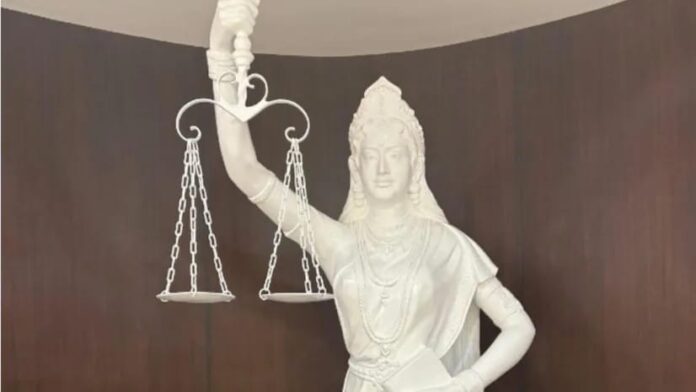Justice Will No Longer Be ‘Blind’: Supreme Court embraces new symbolism
The Supreme Court of India has unveiled a redesigned version of the ‘Lady Justice’ statue, a move that breaks from colonial-era symbolism and reflects a new vision of justice in the country. Traditionally, Lady Justice has been portrayed with a blindfold to represent impartiality and a sword to signify authority.
However, the redesigned statue replaces the blindfold with open eyes and swaps the sword for the Constitution of India, symbolising the judiciary’s commitment to constitutional values and an inclusive view of justice that “sees everyone equally.”
Symbolism of Open Eyes
The decision to remove the blindfold has profound implications. In traditional representations, the blindfold has symbolised an unbiased approach to justice, suggesting that the law would judge without prejudice or favouritism. Now, with her eyes open, Lady Justice symbolises a system that is vigilant, aware, and actively ensures fairness by “seeing everyone equally.” Chief Justice of India D.Y. Chandrachud, who led the unveiling, described the statue as a reflection of a legal philosophy that acknowledges the judiciary’s role in upholding the rights and dignity of all citizens in a transparent and conscious manner. He stated, “The law is not blind; it sees everyone equally,” emphasizing a judiciary that is awake to its responsibilities and the diverse challenges within society.
Constitution Replacing the Sword
In place of the sword, Lady Justice now holds the Constitution of India. Traditionally, the sword has represented authority, power, and punishment. However, replacing it with the Constitution shifts the focus towards a justice system rooted in principles, rights, and fairness over retribution. This choice symbolizes a move toward delivering justice based on constitutional laws rather than punitive measures. A senior official in the Chief Justice’s office elaborated, “The sword is a symbol of violence, but courts deliver justice according to constitutional laws. The new statue aims to reflect this principle,” highlighting a judiciary that acts to protect the rights and dignity of all people under the law.
Breaking from Colonial Legacy
The redesign of Lady Justice aligns with a broader effort within India to move away from colonial-era symbols and practices, reflecting a judiciary that embraces a uniquely Indian identity. Recent legal reforms further underscore this commitment to modernize the justice system and reflect India’s values. For example, the introduction of the Bharatiya Nyaya Sanhita (BNS) to replace the Indian Penal Code (IPC) is a step in this direction. Chief Justice Chandrachud has been vocal about the need to move past British-era symbols, laws, and practices, stating that the role of India’s judiciary should be to protect constitutional rights and promote justice rather than just enforce punitive measures.
A source close to the Chief Justice explained, “Justice Chandrachud believes that India should move forward from the British legacy and that the law is never blind; it sees everyone equally.” This updated philosophy is now represented by the redesigned Lady Justice statue, symbolising a commitment to fairness, inclusivity, and the Constitution as the primary source of justice.
Retaining the Scales of Justice
Despite these changes, one essential feature remains unchanged—the scales held by Lady Justice. These scales represent the balanced weighing of evidence, ensuring that each side in a legal dispute is considered equally before a judgment is made. The scales are a crucial symbol, representing the fairness and balance that courts aim to uphold in every case.
An official clarified, “The scales of justice represent balance in society, and the idea that facts and arguments by both sides are weighed by courts before arriving at a conclusion.” In keeping with this vision, the judiciary aims to remain an impartial arbiter, balancing evidence and arguments from all parties.
A New Indian Symbol for Justice
This statue of Lady Justice, with its open eyes and Constitution in hand, represents a modernized justice system that draws on India’s own values and identity. With the colonial-era blindfold removed, it reflects a judiciary that strives to be aware and conscious of its role in an increasingly diverse and complex society, aiming for a system that protects rights, promotes equality, and sees every citizen under the light of justice.
Continued Symbolic Reforms in the Judiciary
This change comes amid other reforms in the judiciary that echo the same sentiment. Under Chief Justice Chandrachud’s leadership, the judiciary is distancing itself from colonial traditions and embracing a more Indian vision of justice. These reforms are part of an ongoing process to create a system that reflects India’s unique cultural and legal heritage.
By embracing these symbols, the Supreme Court of India has signaled a new era of justice—one that is inclusive, rooted in the Constitution, and conscious of its duty to the people.
Follow the Neptune Prime channel on WhatsApp: https://whatsapp.com/channel/0029Va74ZvU2v1IqKByXoX3d
Do you have breaking news, interview request, opinion, suggestion, or want your event covered? Email us at neptuneprime2233@gmail.com


